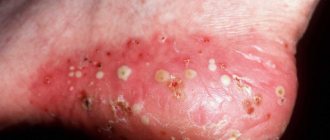Many women experience acne before ovulation. They bring many unpleasant sensations, such as redness, itching and soreness, as well as an unaesthetic appearance. Their occurrence is not affected in any way by skin care, since they are a consequence of hormonal disorders in a woman’s body. Such rashes require treatment with pharmaceutical drugs and traditional medicine to avoid more severe complications.
How long does it take for signs of pregnancy to appear?
The initial signs of pregnancy appear in the second or third week after the end of menstruation, that is, about a week before the calendar start of the next menstruation.
Mucus discharge during pregnancy
Before the onset of menstruation, most women experience thick and scanty discharge called “leucorrhoea.”
After fertilization, due to the high level of progesterone, the work of the cervical glands, which produces mucus, is activated. Therefore, from the first days of conception, mucous discharge becomes more abundant, transparent and has a liquid consistency. It is this secret that protects the pregnant woman and the fetus directly from pathogenic microorganisms.
Thrush during pregnancy
The secretion secreted by the uterus is rich in hydrogen ions, so yeast easily multiplies in it, causing thrush, accompanied by white curdled discharge, itching and burning in the vaginal area.
Candidiasis during pregnancy can also develop against the background of a disturbance in the vaginal microflora.
To avoid intrauterine infection of the fetus, if signs of thrush appear, you should immediately consult a doctor.
Frequent urination during pregnancy
Often, increased frequency of urination is observed in late pregnancy, which is caused by the growth of the fetus in the womb and its pressure on the bladder and ureter.
But even in the first weeks of bearing a child, the urge to urinate may become more frequent, both during the day and at night, which is associated with increased blood circulation in the pelvic organs.
The expectant mother feels as if her bladder is full, and a small amount of urine is released during urination.
If frequent urination does not cause any discomfort, there is no need to worry about it.
Cystitis during pregnancy
Increased urination during pregnancy, accompanied by pain in the groin, burning in the ureter and increased temperature, may be a symptom of cystitis - a disease that often develops in the early stages of pregnancy due to a sharp decrease in immunity, increased susceptibility to bacteria and exacerbation of inflammatory processes.
Temperature 37 as a sign of pregnancy
An increase in body temperature to subfebrile levels (37.2 - 37.4 ° C) in the early stages of pregnancy in the absence of symptoms of viral diseases is normal in 8 cases out of 10. And it is explained by the increased production of progesterone, which affects the thermoregulation center, as well as physiological immunosuppression, which protects the body of a pregnant woman from rejection of the fetus.
A rise in temperature to 37.5°C should be a reason to visit a doctor.
Increase in basal temperature during pregnancy
This sign of pregnancy is informative only in the first 2 weeks after conception, after which the basal body temperature stabilizes.
Pregnancy is indicated by an increase in basal temperature for several days in a row to 37.0 - 37.2 ° C.
It is important to measure basal temperature correctly: the thermometer is inserted into the rectum immediately after waking up in the morning, without getting out of bed. It is recommended to carry out this procedure every day at the same time for several days.
Bloating (flatulence) during pregnancy
Starting from the early stages of pregnancy, intestinal motility is disrupted, which leads to increased gas formation and bloating.
Thus, already in the first weeks of conception, pregnant women may experience a feeling of excessive fullness in the abdomen, accompanied by a tingling sensation radiating to the uterus.
Constipation and diarrhea during pregnancy
Sex hormones produced during pregnancy inhibit the functioning of the intestines, causing it to relax, which causes constipation or, on the contrary, diarrhea. At the same time, constipation most often torments pregnant women in the later stages of pregnancy, while diarrhea is more typical in the first month of pregnancy.
Hemorrhoids during pregnancy
Frequent constipation and blood flow to the pelvic organs can provoke the formation of hemorrhoids, which mainly form in late pregnancy.
However, if before pregnancy a woman suffered from hemorrhoids, then this pathological condition often worsens in the first few weeks after conception.
Leg cramps during pregnancy
Cramps and pain in the legs often bother pregnant women at night. Cramps are manifested by involuntary sharp and painful contraction of the calf muscles.
To eliminate cramps, follow these recommendations:
- Stand on your flattened leg. If acute pain prevents you from moving your leg, you must, overcoming the pain, pull your foot towards you.
- Rub the cramped muscle using pinching and patting.
- Make a hot foot bath with salt.
Mid-cycle acne: treatment
The best thing you can do for hormonal acne is, first, find out with the help of your doctor what your main acne problem is, and, second, follow all the basic recommendations from your doctor regarding the mid-cycle facial acne treatment process.
In general, the hormonal dysregulation that leads to acne can be broken down into several broad categories. Depending on the category of the condition, there will also be differences in how you treat mid-cycle acne:
- high testosterone from PCOS (especially overweight and insulin-resistant type of PCOS);
- low estrogen with low body fat, chronically restricted or living in an energy deficit;
- low estrogen from menopause;
- high progesterone from a general hormone imbalance, possibly associated with PMS;
- any of the above conditions worsened by stress or hypothyroidism.
External signs of pregnancy
A change in a woman’s appearance already in the early stages may indicate pregnancy.
Acne during pregnancy
A sharp hormonal change in the body of a pregnant woman and increased activity of the sebaceous glands can trigger the appearance of acne, even if the woman has not previously encountered this problem.
Most often, the rash goes away after the baby is born and does not require any treatment.
If a pregnant woman decides to deal with rashes before delivery, then she should remember that during this period it is forbidden to use drugs that contain retinoids and salicylic acid. In addition, removal of rashes using laser, deep peeling, or mechanical cleaning is contraindicated. Phytotherapeutic procedures should also be treated with caution.
Facial redness during pregnancy
Such an early sign of pregnancy as facial redness is associated not only with hormonal levels, but also with increased blood circulation during this period.
Many pregnant women experience the so-called “pregnant mask”, which is characterized by the appearance of age spots localized in the forehead, cheeks and nose. You should not be afraid of such spots, since after childbirth they will go away on their own over time.
Veins during pregnancy
The onset of pregnancy may be marked by the appearance of venous patterns (or spider veins) on the chest, neck, arms and legs. Such spider-like patterns of dark red or bluish color, like skin pigmentation, will disappear on their own with the birth of the child.
Edema during pregnancy
In the early stages of pregnancy, slight puffiness of the face may be observed. In addition, your hands may swell, which is especially noticeable if you clench your hand into a fist.
It should be remembered that swelling in the first months of bearing a child is not normal and may indicate that the expectant mother has kidney disease or cardiovascular disease. Therefore, if this symptom appears, you should consult a doctor.
Breast enlargement during pregnancy
Many women, due to the absence of menstruation, may suspect pregnancy in the first weeks of conception due to breast enlargement by 1 - 2 sizes. Moreover, this sign can be observed even if a woman loses her appetite and loses weight.
Breast enlargement may be accompanied by pain and tingling in both mammary glands.
Important! During pregnancy, both breasts increase in size exactly the same. Enlargement of one mammary gland or any part of it should alert you, as it may signal the presence of serious diseases.
Nipple changes during pregnancy
Early signs of pregnancy are darkening and swelling of the nipples, as well as the appearance of Montgomery tubercles - small outgrowths localized in the nipple area. Outwardly, such formations resemble small warts that are filled with a sebaceous substance.
There is no need to worry about the appearance of such tubercles, since they in no way disrupt the functioning of the sebaceous glands and do not affect the health of the expectant mother, much less the fetus.
Pain and burning sensations that occur when touching the nipples may also indicate pregnancy.
Discharge from the breast during pregnancy
An early (albeit rare) sign of conception may be clear fluid released from the nipple when pressure is applied to it.
Sometimes, in early pregnancy, colostrum may begin to be released, which indicates galactorrhea, a condition in which there is increased production of the hormone prolactin.
In general, the appearance of colostrum is more typical in the second and third trimesters of pregnancy.
Stripe on the stomach during pregnancy
Many people believe that a brown line on the abdomen, running from the navel down, appears in late pregnancy. In fact, this line can be seen already in the first weeks of pregnancy, it will simply be white, whereas from the 12th week it will begin to acquire a brown tint.
Subcutaneous acne on the face before menstruation: causes
Approximately 80% of women complain of increased acne or the appearance of acne before menstruation. This usually occurs in the second phase of the menstrual cycle, approximately 10-12 days before bleeding. Scientists explain this phenomenon by the fact that due to the narrowing of the mouth of the pilosebaceous follicle, micro-edema of the skin occurs. Against the background of follicular hyperkeratosis, the outflow of sebum is hampered.40
Pathogenetically, this condition is caused by stimulation of the renin-aldosterone-angiotensin system by progesterone and estrogens with further retention of water and sodium. In the appearance of a rash on the face before menstruation, an important role is assigned to two links in the pathogenesis of acne - increased sebum production (initial link), follicular hyperkeratosis (the result of the dominance of keratinization processes over desquamation processes occurring in the ducts of the sebaceous glands). 40
The initial link may be hyperandrogenism, which manifests itself in the form of increased hormone levels (absolute) or in the form of increased sensitivity of receptors to androgens (relative). The role of androgens in the physiology of the female body has received less attention compared to progesterone and estrogens, however, their effect cannot be completely excluded from the pathogenesis of acne. 40
Signs of the first and second pregnancy
Are the early signs of the first and second pregnancy different? We answer: everything is purely individual. There are many cases where the same woman’s first pregnancy occurred against the background of severe toxicosis, while bearing a second child did not cause any problems.
In general, gynecologists identify the same early signs of pregnancy, regardless of whether it is the first, second or third. However, pathologies such as hemorrhoids and varicose veins during the second and subsequent pregnancies become aggravated already in the first weeks of gestation.
Monitor your bowel movements
When the embryo attaches to the endometrium of the uterus, the expectant mother's hormonal system changes. Metabolism slows down, and maximum energy is devoted to the most important process - the development of the embryo. Because of this, peristalsis worsens, gas formation increases and stool upset occurs.
Diarrhea is a symptom of pregnancy, affecting one in four women.
Hormonal changes occur regardless of whether fertilization was done using IVF or natural methods. It can lead to changes in taste preferences, nausea and vomiting. If early toxicosis appears, you should temporarily avoid any foods that are not absorbed by the body.
Signs of pregnancy while breastfeeding
Many women mistakenly believe that it is impossible to get pregnant while breastfeeding. This is wrong.
Let's look at the signs that may indicate that a nursing mother is pregnant again.
If your baby refuses to breastfeed for no apparent reason, consider purchasing a pregnancy test. The fact is that a new pregnancy provokes a change in the taste of breast milk, which acquires a bitter taste and becomes less sweet.
The consistency of the milk itself may change, as well as its quantity (up to its complete disappearance).
You should also pay attention to persistent hypersensitivity, as well as soreness of the nipples, especially if such signs were not previously observed during breastfeeding.
Darkening of the skin around the nipples may also indicate pregnancy.
The absence of menstruation, provided that it has already occurred after childbirth, can also be a sign of pregnancy.
Cystitis or early pregnancy?
Changes in hormonal levels affect all organs, including the bladder. At the same time, the amount of mucus produced in the vagina of the expectant mother increases, which is why bacteria can enter the urethra. The intensity of blood flow in the pelvic area increases, so the woman feels pain just above the pubis and frequent urges.
If other symptoms of cystitis - cloudy color, blood in the urine - are absent, discomfort may be a sign of pregnancy. Do a test to be sure.
Laboratory and instrumental diagnosis of pregnancy
Regardless of whether you have subjective or external signs of pregnancy, the fact of conception can only be reliably confirmed using laboratory and instrumental diagnostic methods: transvaginal ultrasound and a blood test for hCG.
Thus, an ultrasound examination can determine pregnancy starting from the fourth week from the moment of conception. But in the first week of pregnancy, an ultrasound will only show the presence of a corpus luteum, which cannot be a reliable sign of the birth of a new life.
In the first 7 to 9 days after conception, in 98% of cases, pregnancy can be determined by a blood test for hCG , in which the human chorionic gonadotropin level exceeds 25 mU/ml. An increase in hCG levels during pregnancy is observed up to 12 weeks, after which it begins to gradually decrease.
At home, women use rapid tests .
Pregnancy test
An express pregnancy test, which can be purchased at a pharmacy, is recommended to be carried out no earlier than 2 to 3 days before the expected start date of menstruation. At the same time, manufacturers recommend using tests to determine pregnancy after 5 days of delay in order to avoid obtaining unreliable results.
The test is positive, but there are no signs of pregnancy
Some women are faced with a situation where an express pregnancy test gives a positive result in the absence of any signs of pregnancy, confirmed by a gynecologist and ultrasound.
The reasons for a false positive pregnancy test may be the following:
- Incorrect test: biomaterial (urine) is collected in the morning, and the last part is used.
- Using expired or defective test.
- Taking medications containing human chorionic gonadotropin (hCG).
- Hormonal imbalance due to the presence of tumor diseases and cysts.
- Early pregnancy failure.
- Abortion with incomplete removal of embryonic tissue.
- Ectopic pregnancy.
- Taking alkaloids, tranquilizers, and phenothiazane derivatives.
Test negative for early signs of pregnancy
Can a rapid test show a negative result if there are early signs of pregnancy? Maybe. And here are the reasons.
- Premature testing (remember that the most reliable results will be those obtained during the test on the fifth day of a missed period or more).
- Presence of tumors.
- Malfunction of the thyroid gland.
- Taking hormonal drugs.
- Ectopic pregnancy.
- Threat of spontaneous abortion.
- Violation of the rules for using and storing the test.
- Low quality or defective test system.
And remember that if you suspect pregnancy, no matter what the test result is - false positive or false negative, only visiting a gynecologist and carrying out all the necessary examinations will reliably determine whether you are pregnant or not.
Control fluctuations in basal temperature
If you are planning to conceive, chart your temperature. Before the date of ovulation, it usually does not exceed 36 degrees. At the moment the egg is released, the indicator increases by approximately one division.
If the formation of a zygote does not occur, the temperature will return to its previous level. And in the event of the birth of a new life, the value will remain at 37 .










